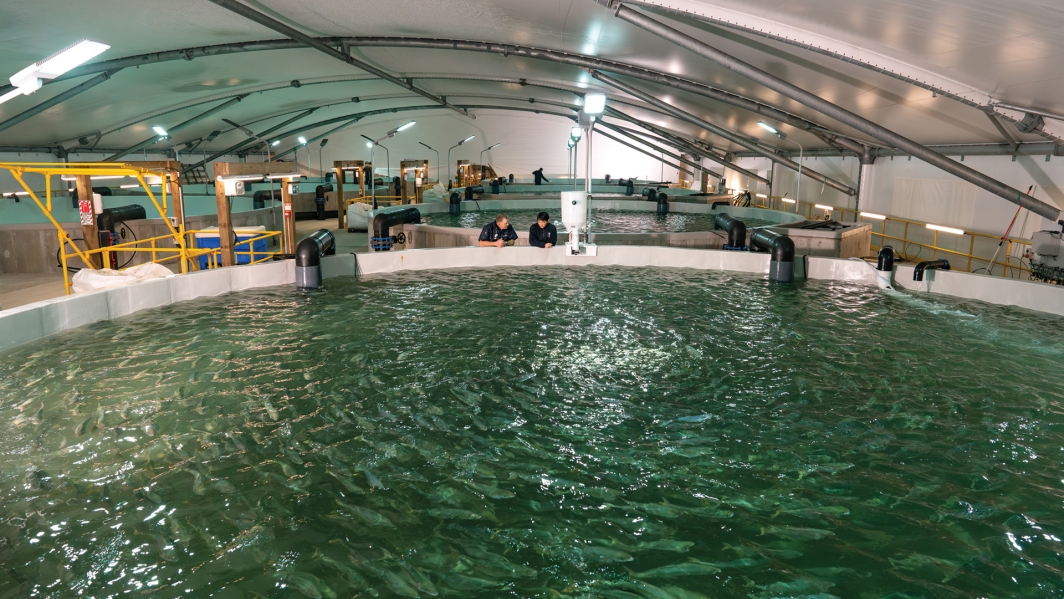The Northland Aquaculture Centre
The team at The Northland Aquaculture Centre has expertise in systems design, new species development, prevention and treatment, handling and harvesting, nutrition, reproduction and physiology. Our dedicated team and facilities can conduct research and work with commercial clients to design and manage marine operations that optimise sustainable aquaculture production and meets high environmental and quality certification standards.
Site overview
Area & site
- 8.2 Hectares, of which about half is developed, the other half available. Surrounded by flat land with future potential. A Service conduit: A 550m long service conduit allows for any new service to be supplied to the all parts of the site with ease. This includes seawater, electricity, freshwater, data, waste removal, etc.
- The new administration building at the Northland Aquaculture Centre offers a number of meeting rooms and office spaces.
Water tanks and volumes
Currently holding 200 research tanks on site, ranging between 200-70,000L with an abundant supply of high-quality seawater Including many flow-though tanks, a 30,000L and 180,000L recirculating aquaculture system (RAS).
Water Filtration & Treatment: The site has consent to take 4m³ of seawater per second through 2.4m diameter pipes. Seawater filtered down to 5 micron, then UV treated. Finer filtration is available as well as ozonated supply if required.Solids Removal: RAS process filtration collects waste solids and these are treated by anaerobic digestion before returning clear water back into the ocean.
Power supply: 240V single phase and 400 three phase.
Laboratories
General lab
General purpose semi-wet laboratory. It contains the -80°C freezer and water quality measurement equipment (spectrophotometer, pH meter, CO2 meter). We also conduct proximate composition analysis using our NIR (near infra-red) instrument to estimate the relative amounts of water, protein, lipid and ash in biological samples (e.g., feed, muscle, viscera, faeces).
Hatchery lab
This multi-purpose dry laboratory is connected to one of our egg incubation rooms, with several instruments available for use. The lab is equipped with two Leica stereomicroscopes, a compound microscope, incubator, -80°C freezer, -20°C freezer, a refrigerator, laminar flow hood and fume hood. A 96-well plate spectrophotometer is also available for colorimetric (e.g., ELISA) assays.
Algae lab
This dry laboratory is attached to our algae facility to support cultures. It houses the reverse osmosis water filtration systems and a large autoclave oven.
Pathology lab
These are comprised of the wet and dry labs. The wet lab is where we conduct necropsies or tissue sampling from deceased fish. The dry lab is where pathology samples are processed further, housing a compound microscope and dissecting equipment.
Feed trials
The Northland Aquaculture Centre has several replicated systems that can be used to run comparative feed trials. These systems can be all be run of freshwater or saltwater, flow-through or with degrees of water re-use, and with precise temperature and environmental control. Within trial areas, groups of tanks can be placed different water supplies to have different temperatures or other environmental conditions within the same trial.
- Larval and nursery feed trial areas: 8 x 5 m³ tanks with temperature, oxygen, light, microbial and feeding control, and 12 x 1.5 m³ tanks with temperature, oxygen, light, microbial and feeding control.
- Juvenile and growout feed trial areas: 42 x 1.5m³ tanks with temperature, gas controls (oxygen, CO2, nitrogen), light and feeding control and feed recovery.
- Broodstock feed trial areas: 4 x 12 m³ tanks temperature, oxygen, light, microbial and feeding control, and 8 x 20 m³ tanks temperature, oxygen and feeding control.
Workshops and machine shops
A dedicated team is responsible for the installation and maintenance of the infrastructure at the Northland Aquaculture Centre. The facility has fully-equipped workshops and machine shops for the construction, maintenance and custom fabrication of scientific equipment, field equipment and aquaculture production systems. The team has significant combined experience in the design, construction and operation of many types of aquaculture systems. Much of the work carried out by the team is bespoke, and often new methods and technologies need to be developed to solve particular problems, as no one else has done it before.
Biosecurity is extremely important to us. A multiprong approach is taken on incoming water disinfection, sanitisation stations at every entry/exit point and close water quality monitoring. Much of this monitoring is carried out on site in our purpose-built laboratories.
Location address: PO Box 147, 101 Sime Road, Ruakaka 0151, New Zealand.
Phone: +64 9 432 5500
Learn more about our kingfish by visiting www.haku.nz

